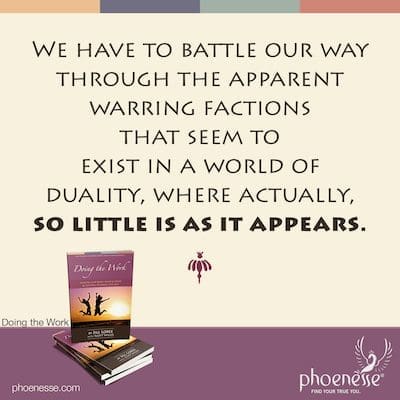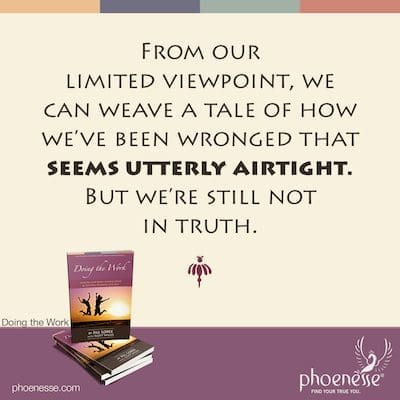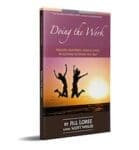Would I Rather be Right or Happy?

The Guide teaches us that every disharmony in life stems from a misunderstanding of truth. The good news is: this means that every negativity can be unwound to find its original positive essence, once we uncover the truth of the matter. The bad news is: we’re going to have to come to terms with the fact that in some way, we’ve been wrong. We haven’t been living in truth.
We can think of truth as being a spectrum that stretches from one end of anything to the other, and therefore truth is able to hold opposites. When this unifying level of truth is known to us, we are at peace. Conversely, when we feel any disharmony within ourselves, we are caught in duality. When that happens, something appears to be true and at the same time in opposition to something or someone else. We have gotten lost in the illusion of duality. In that moment, what we must come to realize is that we are not yet seeing the whole truth. What we are snagged on is our own inner limitation to being in truth.
The Earth plane, then, is a sphere of duality; that’s our current reality. At the same time, all duality is illusion. Both of these are true. (If this tips us over, then we’re likely steeped in duality and don’t even know it.)
When we are able to get our arms so big that we can hold—actually embrace—the opposite positions of any issue, we step out of the plane of duality and enter the plane of unity. Ah, the infamous Oneness. When this happens, our world stops tilting. We enter a different kind of reality where nothing and no one is ever really in opposition to anything or anyone else. All becomes one, just as it already is beyond the veils of the dualistic illusion. Until then, we have to battle our way through the apparent warring factions that seem to exist in a world of duality, where actually, so little is as it appears.

So back to observing our storytelling. We need to become aware of what’s happening when we are trapped in duality, when the world we see in front of us appears to offer only black-and-white options. Or worse, when we’ve gotten ourselves so mired in the muck of duality that the only two options we face are bad and worse.
When we can start to identify that this is duality—that we are now trapped in illusion—we are making progress. Even before we have any inkling of a solution or way out, we are still better off. Because now the speck of our being that is observing our life drama is not caught in the drama. It may only be a speck at this point, but that’s more than we had access to before now.
Again, all duality is illusion. Regardless how convincing the illusion is, it’s still illusion. Our work is to find our way off the struggle bus, and we do that by cracking open the exit door using the tool of awareness. We need to shift away from dualistic thinking and learn to hang out more often in unitive consciousness where real truth resides. (See more about duality in Spilling the Script and in Gems: A Multifaceted Collection of 16 Clear Spiritual Teachings, the chapter called Surrendering to the Double-Sided Nature of Duality.)
Inherent in the restrictive, life-defying strategies we adopt early in life—in an effort to save ourselves—is the narrowing of our vision. Our view of things is sliced and diced into a fragment of reality that no longer has perspective. From such a limited viewpoint, we can weave a tale of how we’ve been wronged that seems utterly airtight. But in the end, we’re always leaving out one important detail: we’re still not in truth.
For once we have the greater truth of any situation in our purview, the disharmony resolves. Every time. So if we’re not walking straight regarding any issue in life, we don’t yet have our arms open wide enough to capture all the truth. What is there to be done about this? Just one thing: we need to pray.
In Jill’s Experience
No two ways about it, duality is a beast. We’re caught in it from the get-go, and the more we veer off course, the more we find our noses pushed up against lose-lose choices. Such is the state I was in when my 10-year marriage to a kind and caring man, who was as lost in the illusion as I was, came to an end. Snagged on our defenses as we were—mine to run as far and fast on an inner level as I possibly could—it’s no surprise we were destined for divorce. There just wasn’t enough of either one of us present to create much of a connection.
I was far enough along on my spiritual path to know that whatever our issues were, if I didn’t work through them then and there, I would only end up facing them again, in front of someone else. But sometimes we just don’t have what we need to get there from here, and that’s where I was. I was lost and getting nowhere, and none of our years in therapy were moving the meter.
I had reached that sinking realization that no matter what, this is going to hurt: if I stay it’s going to hurt and if we split it’s going to hurt. Having arrived at this heart-sickening juncture, I did the only thing I knew to do: I did what I needed to do to save my own bacon.
This is the rough thing about duality. Having made a series of wrong turns, we find ourselves with our backs up against a wall and seemingly no good way out. Had I had the good fortune to have previously found and followed God’s will at every bend in the road, I wouldn’t have ended up where I did. But then a whole lot in my life would have been very different. Indeed, if I was so with-it that I could pick God’s will out of a line-up every time, I wouldn’t have had to come to this sphere to begin with.
And so it was with a certain sadness, and a very deep regret for the effect it had on my young boys, that we made the choice we did and our marriage ended. I wish it could have gone differently; I wish I could have been better. But I’m getting there now, having dedicated many years and not a small amount of dollars to my pursuit of resolving the hidden issues in my psyche that led me to having to make such a hard choice, and that necessarily hurt people I dearly love.
In Scott’s Experience
I was in my late 30s when I got my first management role, with 45 people reporting directly to me. I had left a big corporation for a small firm where I was the new engineering director, the process improvement director, and also had sales/proposal development responsibility. It was crazy too much, but a huge learning and growing opportunity, especially spiritually.
I had to stand up in front of 45 people every day, not only learning a leadership role but also doing my personal spiritual work. Previously I had been doing my spiritual work with some shelter; I didn’t have too many people watching. Now it was time to take it to the next level, to the fire of a new crucible.
I encountered all manner of challenges and trials. Budgets and deadlines were made and sometimes missed. I hired fantastic people and a few miserable ones. My teams worked well and sometimes squabbled. Jobs were won and sometimes lost. There were plenty of instances of disharmony for me to look at.
Disharmony is not really about feeling unpleasant feelings, it is becoming aware of when you manipulate feelings by artificially suppressing, amplifying or distorting them. These are signposts that something is not in truth. And I want to see every place I am not in truth.
By looking at the places in my work life that were difficult and challenging, I noticed that much of the disharmony in my team was a reflection of my own issues. I was directing 45 people’s work lives, and thus putting energy into the system, and the system was bringing its problems and challenges back to me. I began to notice that any place I sent negativity rippling into the organization, however slight, it would be bounced around and reflected back to me, maybe from a different direction. This team of 45 people was a mirror for me, and an effective one at that.
Early on, I hired a Pathwork Helper who was also an organizational change expert as my business coach. I still had my personal Helper too. Together we began to look at my leadership abilities from a combined business and spiritual perspective. After a year in the role, I asked my coach and Helper to go interview people around me about my leadership qualities.
I wanted to understand what the mirror was telling me more explicitly. We spent a month and designed interview questions to give me the best idea where my work remained and how I could grow. Then I selected the most insightful people in the organization, plus family and community people, to be interviewed.
After my coach and Helper completed the interviews, I took a two-day private retreat with them to hear the results. We started the retreat by going through the interviews person by person and question by question. They would ask me how a particular person answered a particular question. I would tell them what I thought the person said, and they would read to me the person’s actual response. If I got the response right, they wrote the answer on a green post-it note. If not, it went on a red post-it note. I guessed correctly more than 80% of the time. They wanted to see how well I knew myself, and I did pretty well at this first step.
Next, we took the notes and put them on the wall, grouping them by themes, and I started to get a big picture view of what my main challenges were as a leader. The red/green variation helped me visualize where I could see well, and where I was blind. Having a lot of perspectives come together made it easier to see a theme more completely, and it told me something about their strength.
Finally, near the end of the two days, I began grouping the themes in relation to each other. Previously they felt a bit random, but I wanted to explore connections between them. As we worked, a new understanding came to light. One of the themes was that sometimes I was inappropriately soft and yielding. Sometimes, if something was due, or a commitment missed, or an infraction made, I would yield on it in a way that wasn’t firm.
Other times, I came down inappropriately hard or abruptly. It wasn’t all the time, it was sometimes, which made it hard to see. Often the pattern came sequentially: I would be over-soft and yielding until something had to change, and then I would come down over-hard. It was just sometimes, not enough for me to clearly see, but just often enough to be maddening to my team. In this way, my team didn’t know what to expect from me.
There was a duality here I had not seen in myself before. I had a soul split between compassion/mercy on one side, and power/accountability on the other side. My compassion was lacking an appropriate firmness and power, and my use of power was lacking an appropriate compassion. In reality, compassion, mercy, power, firmness and accountability are all part of one whole, and I was caught in the duality of a split between them.
Knowing about a dualistic soul split like this is the first step in healing it, but it doesn’t happen with a snap of the fingers. It takes a lot of intention to consciously choose to feel the feelings and examine the associated hidden beliefs, and do the work to close the gaps.
Next Chapter
Return to Doing the Work Contents


